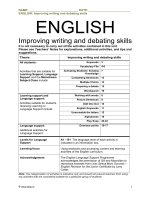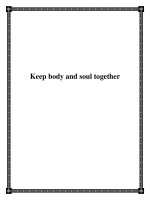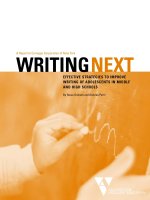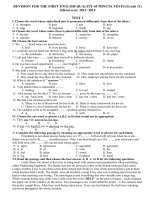Science & Nature - Quality and Unique things pot
Bạn đang xem bản rút gọn của tài liệu. Xem và tải ngay bản đầy đủ của tài liệu tại đây (3.09 MB, 66 trang )
Science and Nature
Uncover the mystery of everyday marvels,
from rocks to rainbows
CHICAGO LONDON NEW DELHI PARIS SEOUL SYDNEY TAIPEI TOKYO
LEARNING
LIBRARY
B
r
i
t
a
n
n
i
c
a
®
© 2008 BY ENCYCLOPÆDIA BRITANNICA,INC.
Cover photos (front): © Lester Lefkowitz/Corbis; (back): © Corbis. Cover insert photos (left): © Jeff Vanuga/Corbis;
(right): © George B. Diebold/Corbis
International Standard Book Number:978-1-59339-504
-9
No part of this work may be reproduced or utilized in any form or by any means, electronic or mechanical, including photocopying,
recording, or by any information storage and retrieval system, without permission in writing from the publisher.
BRITANNICA LEARNING LIBRARY:SCIENCE AND NATURE 2008
Britannica.com may be accessed on the Internet at .
(Trademark Reg. U.S. Pat. Off.) Printed in U.S.A.
PROJECT TEAM
Judith West, Editorial Project Manager
Christopher Eaton, Editor and Educational
Consultant
Kathryn Harper, U.K. Editorial Consultant
Marilyn L. Barton, Senior Production
Coordinator
Editors
Theodore Pappas
Anthony L. Green
Mary Rose McCudden
Andrea R. Field
Michael J. Anderson
Colin Murphy
Locke Petersheim
Indu Ramchandani (Encyclopædia
Britannica India)
Bhavana Nair (India)
Rashi Jain (India)
Design and Media Specialists
Nancy Donohue Canfield, Design
Megan Newton-Abrams, Design
Karen Koblik, Photos
Joseph Taylor, Illustrations
Amy Ning, Illustrations
Jerry A. Kraus, Illustrations
Michael Nutter, Maps
Copy Editors
Barbara Whitney
Laura R. Gabler
Dennis Skord
Lisa Braucher, Data Editor
Paul Cranmer, Indexer
ENCYCLOPÆDIA BRITANNICA
PROJECT SUPPORT TEAM
EDITORIAL
Linda Berris
Robert Curley
Brian Duignan
Kathleen Kuiper
Kenneth Pletcher
Jeffrey Wallenfeldt
Anita Wolff
Charles Cegielski
Mark Domke
Michael Frassetto
James Hennelly
Sherman Hollar
Michael R. Hynes
Sandra Langeneckert
Gene O. Larson
Michael I. Levy
Robert Lewis
Tom Michael
Janet Moredock
DESIGN
Steven N. Kapusta
Carol A. Gaines
Cate Nichols
ART
Kathy Nakamura
Kristine A. Strom
Nadia C. Venegas
ILLUSTRATION
David Alexovich
Christine McCabe
Thomas Spanos
MEDIA ASSET MANAGEMENT
Jeannine Deubel
Kimberly L. Cleary
Kurt Heintz
Quanah Humphreys
COPY
Sylvia Wallace
Jennifer F. Gierat
Glenn Jenne
Mary Kasprzak
Thad King
Larry Kowalski
Joan Lackowski
Dawn McHugh
Julian Ronning
Chrystal Schmit
Sarah Waterman
INFORMATION MANAGEMENT/
INDEXING
Carmen-Maria Hetrea
Edward Paul Moragne
Marco Sampaolo
Sheila Vasich
Mansur G. Abdullah
Keith DeWeese
Catherine Keich
Stephen Seddon
EDITORIAL TECHNOLOGIES
Steven Bosco
Gavin Chiu
Bruce Walters
Mark Wiechec
COMPOSITION TECHNOLOGY
Mel Stagner
MANUFACTURING
Dennis Flaherty
Kim Gerber
INTERNATIONAL BUSINESS
Leah Mansoor
Isabella Saccà
ENCYCLOPÆDIA BRITANNICA, INC.
Jacob E. Safra,
Chairman of the Board
Jorge Aguilar-Cauz,
President
Michael Ross,
Senior Vice President, Corporate Development
Dale H. Hoiberg,
Senior Vice President and Editor
Marsha Mackenzie,
Managing Editor and Director of Production
To help you on your journey, we’ve provided the following guideposts in
Science and Nature
:
■ Subject Tabs—The colored box in the upper corner of each right-hand
page will quickly tell you the article subject.
■ Search Lights—Try these mini-quizzes before and after you read the
article and see how much—and how quickly—you can learn. You can even
make this a game with a reading partner. (Answers are upside down at the
bottom of one of the pages.)
■ Did You Know?—Check out these fun facts about the article subject.
With these surprising “factoids,” you can entertain your friends, impress
your teachers, and amaze your parents.
■ Picture Captions—Read the captions that go with the photos. They
provide useful information about the article subject.
■ Vocabulary—New or difficult words are in bold type. You’ll find
them explained in the Glossary at the end of the book.
■ Learn More!—Follow these pointers to related articles in the book. These
articles are listed in the Table of Contents and appear on the Subject Tabs.
In
Science and
Nature
, you’ll
discover answers to
these questions and many
more. Through pictures,
articles, and fun facts,
you’ll learn about weather,
meet fascinating
scientists, and see how
plants and animals can
change over time.
INTRODUCTION
What are tsunamis?
Why did the dinosaurs disappear? Why do some leaves turn red?
What woman won
two
Nobel Prizes in the sciences?
LEARNING
LIBRARY
B
r
i
t
a
n
n
i
c
a
®
Have a great trip!
Science and Nature
© 2008 Encyclopædia Britannica, Inc.
A fallen maple leaf shows
its autumn colors.
© Royalty-Free/Corbis
© 2008 Encyclopædia Britannica, Inc.
Science and Nature
TABLE OF CONTENTS
INTRODUCTION . . . . . . . . . . . . . . . . . . . . . . . . . . . . . 3
SOME ESSENTIALS
Atoms: Building Blocks of Matter. . . . . . . . . . . . . . . . 6
Liquids, Solids, and Gases:
Same Stuff, Different Forms . . . . . . . . . . . . . . . . . . 8
Echoes: Sounds That See in the Dark . . . . . . . . . . . 10
Energy: The Power of Life . . . . . . . . . . . . . . . . . . . . 12
Leaves: The Science of Their Changing Colors . . . . . 14
PHENOMENA OF NATURE
Temperatures: Hot and Cold. . . . . . . . . . . . . . . . . . . 16
Dew: Diamond Drops of Water . . . . . . . . . . . . . . . . . 18
Clouds: Floating Water. . . . . . . . . . . . . . . . . . . . . . . 20
Rainbows: Arcs of Color. . . . . . . . . . . . . . . . . . . . . . 22
Thunder and Lightning: Nature’s Fireworks . . . . . . 24
Cyclones and Tornadoes: Nature’s Fury . . . . . . . . . . 26
Acid Rain: Killer Downpour . . . . . . . . . . . . . . . . . . . 28
Waves: Movement on the Seas . . . . . . . . . . . . . . . . . 30
Tsunamis: Waves of Destruction . . . . . . . . . . . . . . . 32
GEOLOGY: Studying the Earth . . . . . . . . . . 34
Rocks and Minerals:
The Earth’s Building Blocks. . . . . . . . . . . . . . . . . 36
Chalk: The Remains of Tiny Shells . . . . . . . . . . . . . 38
Sand: The Nitty-Gritty . . . . . . . . . . . . . . . . . . . . . . . 40
Diamonds:
The Hardest-Working Gemstones in the World . . . 42
Volcanoes: Mountains of Smoke and Fire . . . . . . . . . 44
Fossils: Ancient Life in Stone . . . . . . . . . . . . . . . . . 46
Dinosaurs: Giants of the Past . . . . . . . . . . . . . . . . . 48
Dinosaurs: A Mystery Disappearance . . . . . . . . . . . . 50
Tyrannosaur: The Tyrant King. . . . . . . . . . . . . . . . . 52
Mammoths and Mastodons: Ancient Elephants . . . . 54
NATURE SCIENTISTS
Luther Burbank: Inventing New Plants . . . . . . . . . . 56
Marie Curie: Discovering a New Kind of Science. . . . 58
Charles Darwin: The Theory of Evolution . . . . . . . . . 60
GLOSSARY . . . . . . . . . . . . . . . . . . . . . . . . . . . . . . . 62
INDEX . . . . . . . . . . . . . . . . . . . . . . . . . . . . . . . . . . . 63
LEARNING
LIBRARY
B
r
i
t
a
n
n
i
c
a
®
© 2008 Encyclopædia Britannica, Inc.
Everything in the world is made up of molecules. Our bodies,
our clothes, our houses, animals, plants, air, water, sky—everything.
Molecules are so small, though, that we can’t see them with our
naked eyes.
But molecules aren’t the smallest things. Molecules are made
up of atoms, which are smaller still. Atoms are so small that it takes
more than a billion atoms to fill the space taken up by one pea!
The word “atom” comes from the Greek word atomos, meaning
“indivisible.” But despite what their name suggests, atoms can
indeed be divided into smaller pieces. Each atom has a core called
a “nucleus.” Around the nucleus swarm small particles called
“electrons.” The nucleus itself is made up of other small particles
called “protons” and “neutrons.” And these protons and neutrons are
made up of even smaller things called “quarks.” So, for now at least,
quarks are among the smallest known things in the universe.
L
EARN MORE! READ THESE ARTICLES…
ENERGY • LIQUIDS,SOLIDS, AND GASES • MARIE CURIE
B
u
i
l
d
i
n
g
B
l
o
c
k
s
o
f
M
a
t
t
e
r
DID YOU KNOW?
Quarks are so small that scientists
have to make up new ways to describe
them. They talk about the different
“flavors” of quarks—not chocolate or
pistachio but “up,” “down,” “charm,”
“strange,” “top,” and “bottom.”
© 2008 Encyclopædia Britannica, Inc.
ATOMS
7
Answer: FALSE. Atoms can be split into electrons, neutrons, and
protons, all of which are smaller than the atom itself. And quarks
are even smaller than those.
★
True
or false?
Atoms are the
smallest things
of all.
S
E
A
R
C
H
L
I
G
H
T
© 2008 Encyclopædia Britannica, Inc.
8
Did you know that many of the things you may see or use
every day—such as the water in a glass, the air in a football, and
even the hard metal in a toy car—are potential shape-shifters?
The substances that these things are made of can have the
form of a solid, a liquid, or a gas. The form they take depends
mostly on their temperature. When water gets cold enough, it
becomes a hard solid we call “ice.” When it gets hot enough,
it becomes a wispy gas we call “steam.” Many other
substances behave the same way when they are heated or
cooled enough.
A solid holds its own size and shape without needing a
container. If you pour water into an ice tray and freeze it, the
water will keep the shape of the cube-shaped molds in the
tray. You can think of the solid metal in a toy car as frozen
too, but its melting temperature is much higher than the
temperatures we live in. The person who made the car poured
very hot liquid metal into a car-shaped mold and let it cool down
and freeze.
A liquid does not hold its own shape. If you pour
a measuring cup of water into a tall glass or a shallow
bowl, it will take the shape of its container. But that
water does keep its own size. It measures one cup.
Everyday liquids such as milk, paint, and
gasoline act this same way.
Gases do not keep their own shape or
their own size. When air is pumped into
a football, it takes the shape and size of
the ball. As more air is pumped in, the
ball gets harder but not much bigger.
The air changes its size to fit the
space inside the ball.
L
EARN MORE!
READ THESE ARTICLES…
ENERGY • TEMPERATURES
VOLCANOES
S
a
m
e
S
t
u
f
f
,
D
i
f
f
e
r
e
n
t
F
o
r
m
s
© 2008 Encyclopædia Britannica, Inc.
LIQUIDS, SOLIDS, AND GASES
9
Answer: melts = S; turns into a liquid = S, G;
keeps shape = S; has no shape or size = G;
is frozen = S; has no shape = L, G
★
Mark whether
each item below
describes a
solid (S), a liquid (L),
or a gas (G). Some
may match more than
one form.
S
E
A
R
C
H
L
I
G
H
T
• melts
• turns into a
liquid
• keeps shape
• has no
shape or size
• is frozen
• has no shape
DID YOU KNOW?
If you’ve ever smelled gas coming
from a stove, you know it has an odd
odor. But cooking gas has no odor.
What you’re smelling is another gas
with an odor that’s easy to notice. It’s
mixed with the cooking gas so that
people know when there’s a leak.
© 2008 Encyclopædia Britannica, Inc.
10
“Hel-l-o-o-o-o-o!”
A boy hears the echo coming from the hills.
“Echo, talk to me,” he calls.
“ to me,” repeats the echo. “ to me to me to me.”
What is an echo? It’s a sound you make that bounces back to you from
hills or other surfaces. But how can a sound bounce? It’s not a ball.
Actually, sound is a wave in the air. If you could see air the way you
see water, you’d see the waves that sounds make. Sound waves bounce
only if they hit something big and solid like the side of a hill or the walls
of a cave.
What if nothing stops the sound waves? Then they just get smaller
and smaller. Or they are absorbed by soft things such as carpets, draperies,
or large pieces of furniture. That’s why we don’t usually hear echoes in
the house.
S
o
u
n
d
s
T
h
a
t
S
e
e
i
n
t
h
e
D
a
r
k
DID YOU KNOW?
It is said that a duck’s quack is the
only sound that doesn’t echo. If you
happen to have a duck and a long
hallway, you could test this theory
yourself.
© 2008 Encyclopædia Britannica, Inc.
ECHOES
11
Did you know that echoes can help some animals “see” in the dark?
In pitch-dark caves bats fly easily, never bumping into anything and
even catching tiny insects in the air. As they fly, they make tiny whistlelike
sounds. These sounds bounce back to them. The direction of the echo and
the time it takes for it to return tell the bats exactly where things are as
they fly.
Human beings have learned to harness the power of echoes for
navigation too. Submarines traveling underwater use sonar to bounce
sounds off of solid objects so that they can tell where those objects are
located—sort of like undersea bats!
L
EARN MORE! READ THESE ARTICLES…
ENERGY • RAINBOWS • WAVES
Answer: Bats use echoes to tell what is around them in the dark.
Dolphins do the same thing underwater.
★
What
animal
uses sound
to “see”?
S
E
A
R
C
H
L
I
G
H
T
© 2008 Encyclopædia Britannica, Inc.
12
Without energy in our bodies, we wouldn’t be able to do anything. We
couldn’t walk, talk, or even play. Energy is usable power. And all energy
is related to some kind of motion.
All living things need energy, no matter what they do. Plants get their
energy from sunlight. This energy is stored in different chemicals inside
the plant. This whole process is called “photosynthesis.”
Animals that eat plants take the energy stored in the plants. The energy
is then stored in chemicals inside the animals as “food energy.” The same
happens when animals eat other animals.
Plants and animals use energy every day as they grow and do the work
of being a plant or an animal. So plants have to keep absorbing sunlight,
and animals have to keep eating plants or other animals.
It isn’t only living things that have energy. A dead tree has hidden
energy. When we burn its wood, it gives off warmth, or “heat energy.” The
Sun too makes heat energy as it constantly burns.
The Sun gives off not just heat but also light, as “light energy.” A
battery in a flashlight makes it shine, generating light energy. But if
we put the same battery in a radio, we get music. A battery’s
energy is known as “electrical energy.” And in a toy car that
electrical energy produces movement, or “kinetic energy.”
If we couldn’t use heat, light, or electrical energy, we
couldn’t drive cars or cook food. We wouldn’t have light at
nighttime. Basically, we’d have to use the energy of our own
bodies. And that would mean eating a lot more and doing a
lot less.
T
h
e
P
o
w
e
r
o
f
L
i
f
e
LEARN MORE! READ THESE ARTICLES…
MARIE CURIE • LEAVES
THUNDER AND LIGHTNING
© 2008 Encyclopædia Britannica, Inc.
ENERGY
13
Answer: Heat energy comes from things that burn
.
Food energy comes from things people or animals eat
.
★
These
sentences are
all mixed up.
See if you can
fix them.
Heat energy comes
from the things people
or animals eat.
Food energy comes
from things that burn.
S
E
A
R
C
H
L
I
G
H
T
DID YOU KNOW?
Energy from food is measured in
calories. A grownup needs to take in
about 2,000-2,500 calories a day.
Bicyclists in a major race eat three to
five times that much, and they still
sometimes run out of energy.
© 2008 Encyclopædia Britannica, Inc.
14
Find and
correct the
error in the
following sentence:
Leaves turn red
if they have a lot of
carbon dioxide in them
when the sunlight
shines on them.
S
E
A
R
C
H
L
I
G
H
T
© 2008 Encyclopædia Britannica, Inc.
LEAVES
15
Answer: Leaves turn red if they have a lot of sugar in them when
the sunlight shines on them.
★
Trees that shed their leaves every year are called “deciduous” trees.
Their leaves grow back again in spring.
Scientists think that plants get rid of things they can’t use. After flowers
have helped make new seeds for a plant, their petals fall off. And soon after
leaves have lost their green stuff, called “chlorophyll,” they fall off.
A leaf’s chlorophyll uses sunlight to make sugar out of water and
carbon dioxide, a gas in the air. Plants need carbon dioxide to live and
grow. When leaves use carbon dioxide, another gas, called “oxygen,” is left
over. The plant can’t use the oxygen. So it lets the oxygen go.
Animals and humans need oxygen to live. Their bodies use the oxygen,
and what do you think they have left over? Carbon dioxide. When animals
and humans breathe out, they let the carbon dioxide go.
It’s easy to see that plants and animals and humans help each other
this way.
In places where it gets cool in autumn, a plant loses its chlorophyll,
and its leaves may turn yellow or red. The yellow was there all summer,
but there was so much green that the yellow didn’t show until the green
went away.
Yellow leaves turn red only if they have lots of
sugar in their sap and the sunlight shines on them.
The more sugar a leaf has, the redder it becomes. If
a leaf is kept in the shade, it will stay yellow even if
it has a lot of sugar.
L
EARN MORE! READ THESE ARTICLES…
LUTHER BURBANK • ENERGY • RAINBOWS
T
h
e
S
c
i
e
n
c
e
o
f
T
h
e
i
r
C
h
a
n
g
i
n
g
C
o
l
o
r
s
DID YOU KNOW?
Deciduous forests are one of the
world’s six major life zones: the often
frozen tundra, the mostly evergreen
taiga, temperate (mild) deciduous
forest, tropical rainforest, grassland
and savanna, and desert.
© 2008 Encyclopædia Britannica, Inc.
16
Temperature
measures how
much
a) heat something has.
b) chill something has.
c) pressure something has.
S
E
A
R
C
H
L
I
G
H
T
DID YOU KNOW?
It’s better to use your hand than your
foot to test the temperature of bath
water. If you test too-hot bath water
with your foot, you’re likely to burn that
foot. That’s because it takes longer for
your foot to recognize temperature
than it does your hand.
© 2008 Encyclopædia Britannica, Inc.
TEMPERATURES
17
We can use our fingers, our tongue, or almost any part
of our skin to feel just how hot or how cold something is.
This is important because our bodies need just the right
amount of heat so that we can live comfortably.
When it’s cold and we want to make a room warmer,
we turn on the heaters. In the summer when it’s hot and
we want to make the room cooler, do we add cold to
the room?
No. We take away some of the heat. We say
something is cold when it doesn’t have much heat. The
less heat it has, the colder it is.
Air conditioners suck hot air from a room. Pipes
inside the air conditioners take a lot of heat out of the air,
making it cold. Then a blower fans the cooled air into the
room again.
When we want to know exactly how hot or how cold
something is, we use a thermometer. A thermometer tells
us about temperature—that is, how hot something is.
Some countries measure temperature in “degrees
Fahrenheit (° F).” Others use a different measuring
system of “degrees Celsius (° C).”
We can use thermometers to measure air temperature,
oven temperature, even body temperature. And your body
temperature tells not only whether you feel hot or cold
but whether you’re healthy.
L
EARN MORE! READ THESE ARTICLES…
DEW • LIQUIDS,SOLIDS, AND GASES • VOLCANOES
Answer: a) heat something has.
★
H
o
t
a
n
d
C
o
l
d
© 2008 Encyclopædia Britannica, Inc.
18
DID YOU KNOW?
People used to think that tiny spider
webs in the grass were actually the
beds of fairies. This is because the
webs, covered with dew, looked like
magic nets.
© 2008 Encyclopædia Britannica, Inc.
DEW
19
Susan and her mother had come to the park for an early morning
walk. The weather had been nice and warm recently. The nights
were still, and there was hardly a cloud in the sky.
The park’s grass glittered and winked. “Are those diamonds?”
Susan asked. It looked as if someone had sprinkled tiny diamonds all
across the grass during the night.
Susan bent down to touch one
of the glittering points. “It’s
water!” she cried out in
surprise. “How did it get here?
Did it rain last night?”
“No, this isn’t rainwater. It’s dew.”
“What’s dew?” Susan was eager to
know.
“It came from the air. All air has
some water in it, you know,” said Mother.
“But I don’t see any water in the air,” said Susan, looking around.
“No, of course you don’t. It’s in the form of vapor, like fog, only very
light,” said Mother.
“So how does the water get onto the grass?”
“You know that steam turns into water again if it touches something
cold, right?” Susan nodded. “Well, on certain nights the air is warm and
full of moisture,” Mother continued, “but the grass and the ground are cool.
So when the vapor in the warm air touches these cooler surfaces ”
“ it changes to water drops on the grass,” finished Susan. “That must
be why sometimes in the morning our car is covered with tiny drops of
water.”
“That’s right,” Mother smiled. “Now let’s get going on that walk!”
L
EARN MORE! READ THESE ARTICLES…
CLOUDS • DIAMONDS • LIQUIDS,SOLIDS, AND GASES
Answer: When warm air touches the cool ground, the water in the
air turns into drops of dew.
★
© Julie Habel/Corbis
D
i
a
m
o
n
d
D
r
o
p
s
o
f
W
a
t
e
r
© W. Perry Conway/Corbis
How
does warm
air make dew?
S
E
A
R
C
H
L
I
G
H
T
© 2008 Encyclopædia Britannica, Inc.
© W. Perry Conway/Corbis
20
Have you ever looked up at the clouds and wondered what they’re
made of?
Well, they’re made of water—thousands of gallons of water, floating
high in the air.
It’s easier to believe this when you know that cloud water takes the
form of tiny droplets. The droplets are so tiny that you couldn’t see one if
it was separated from all the others.
Sometimes the water droplets join together around tiny pieces of dust
in the air. These drops get bigger and bigger as more droplets collect.
When they become too heavy to float, they fall—“plop!” That’s rain!
There are three main kinds of clouds. “Cumulus” refers to the small
puffballs or great wooly-looking clouds that are flat on the bottom.
“Stratus” are low clouds, usually streaky or without much shape. And
“cirrus” are light feathery clouds, like the ones in the photo. Sometimes
cirrus clouds are so high, where the air is very cold, that the whole cloud is
made of ice.
Adding “nimbus” to any of these names changes it to mean a rain
cloud. Tall white cottony rain clouds are called “cumulonimbus,” or
thunderheads. They often bring thunderstorms. Flat gray rain clouds are
called “nimbostratus.” They usually bring only rain.
Snow, sleet, and hail also fall from clouds. Snow and
sleet fall only on cold winter days. Hailstones can fall even
on a warm summer day.
And you may not realize it, but you’ve probably been
right inside a cloud yourself. A cloud so close to the ground
that we can walk through it is what we know as “fog.”
L
EARN MORE! READ THESE ARTICLES…
LIQUIDS,SOLIDS, AND GASES
RAINBOWS • THUNDER AND LIGHTNING
F
l
o
a
t
i
n
g
W
a
t
e
r
Which of
the following
describes a
cumulonimbus cloud?
a) cloud on the ground
b) sleet cloud
c) fog
d) thunderhead
S
E
A
R
C
H
L
I
G
H
T
© 2008 Encyclopædia Britannica, Inc.
CLOUDS
Answer: d) thunderhead
★
DID YOU KNOW?
Being on “cloud nine” means you are
feeling especially good, flying high.
One explanation for the term comes
from the military, where cloud types
were numbered. Type nine was a tall
thunder cloud, and jets would have
to fly very high to get over one.
© 2008 Encyclopædia Britannica, Inc.
© 2008 Encyclopædia Britannica, Inc.
RAINBOWS
23
If you’ve ever looked at a rainbow and wondered how all those bright
colors got in the sky, you’re not alone.
The ancient Greeks thought these arcs of color were signs from the
gods to warn people that terrible wars or storms were going to
happen. The Norse people believed a rainbow was a bridge the
gods used to walk down from the sky to the Earth. Other
legends said there was a pot of gold waiting at the end of a
rainbow.
But as beautiful as rainbows are, they aren’t magic. And they
aren’t solid enough to walk on. In fact, a rainbow is just colored
light. The seven colors are always the same and appear in the
same order: red, orange, yellow, green, blue, indigo (a very deep
blue), and violet. The name “Roy G. Biv” helps you remember
the first letters and the order of the colors.
Rainbows often appear after or at the end of a storm—
when the Sun is shining again but there is still some rain in
the air. The sunlight looks white, but all seven rainbow colors are mixed
together in it. So when a beam of sunlight passes through raindrops, it’s
broken into the seven different colors.
But you don’t have to wait for rain to see
rainbows. They can show up in the spray of a
fountain or a waterfall, or you can make your own
with a hose. Set the nozzle to create a spray, aim it
away from the Sun, and then stand between the Sun
and the spray. You’ve got an instant rainbow!
Answer: The name gives you the first letter of each of the colors
of the rainbow, in the order that they occur in the rainbow. Like
this: R
ed Orange Yellow Green Blue Indigo Violet.
★
© Jeff Vanuga/Corbis
A
r
c
s
o
f
C
o
l
o
r
How can the
name “Roy G.
Biv” help you
remember the
colors of the
rainbow?
S
E
A
R
C
H
L
I
G
H
T
DID YOU KNOW?
In spite of some legends, there
really is no “end” of a rainbow.
Rainbows are actually full
circles. But because we can
see only a limited distance, to
the horizon of Earth and sky,
we see only part of the circle.
LEARN MORE! READ THESE ARTICLES…
CLOUDS • ECHOES • THUNDER AND LIGHTNING
© 2008 Encyclopædia Britannica, Inc.
24
It can be fun playing in a gentle rain, splashing in puddles
and chasing raindrops. But this would be a dangerous thing to
do when there are thunderheads above.
Thunderheads are the large, dark, often fast-moving clouds
that come out during storms. Thunderheads rumble mightily
during storms, and that rumbling indicates the presence of
lightning. The rumbling is the sound lightning makes as it
arcs across the sky.
During a thunderstorm, electricity collects in the clouds. And often that
electricity gets released as lightning. It’s dangerous to be out when
lightning is a possibility because lightning can quite easily kill from miles
away. People have died from lightning strikes even though the storm the
lightning came from was barely visible on the horizon.
Lightning bolts frequently race to the ground, drawn by objects such as
trees and lamp posts that are especially good conductors of electricity.
Lightning is most attracted to tall objects, which is why trees, buildings,
and radio towers are often struck.
Actually, there are two parts to a lightning strike. The bolt from the sky
is the part we don’t see, because it is so fast and faint. The part we do see
is the return strike. This is a bright flash of lightning that jumps up out of
the ground to meet the lightning coming down and then races up to the
base of the clouds.
Lightning can hurt or kill people who are struck by it. If you ever are
caught in a lightning storm, get inside quickly. Or get into a car. Lightning
that hits a car will travel into the ground harmlessly.
L
EARN MORE! READ THESE ARTICLES…
CLOUDS • ECHOES • RAINBOWS
N
a
t
u
r
e
’
s
F
i
r
e
w
o
r
k
s
DID YOU KNOW?
Florida is known as the “lightning
capital of the world.” Every year
lightning strikes in Florida more
often than any other state in the
United States. Also, lightning kills
more people in Florida than in any
other state.
True or
false?
In a thunderstorm
it’s a good
idea to take shelter
under a tree.
S
E
A
R
C
H
L
I
G
H
T
© 2008 Encyclopædia Britannica, Inc.









